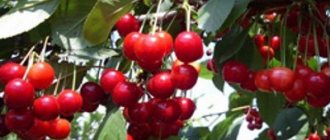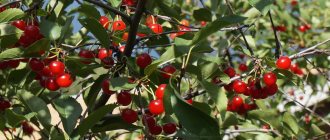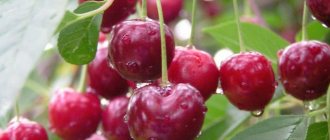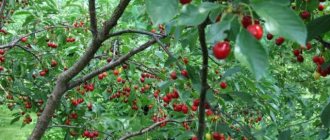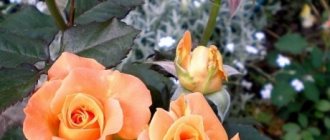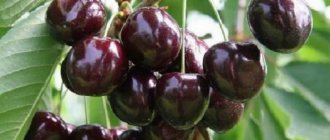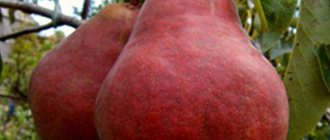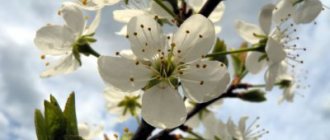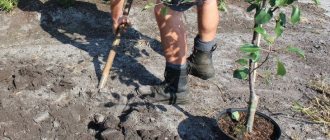Description of Nord Star cherry
Nord Star cherry is a low-growing, compact tree. The crown is quite thick and wide, round in shape. The color of the bark of the trunk and branches is dark brown. The leaves are narrowly oval, small in size, shiny. The Nord Star cherry variety is adapted for cultivation in southern latitudes and central Russia.
Height and dimensions of an adult tree
The maximum active growth of a tree is observed at a young age. From the moment it enters the fruiting stage it becomes moderate. The height of the Nord Star cherry at the age of ten is 2.-2.5 m.
Young tree Nord Star
Description of fruits
Main characteristics of cherry fruits of the Nord Star variety:
- berry weight – 4-4.5 g;
- shape – round or wide-round;
- the skin is thin, shiny;
- color – dark red;
- pulp – reddish, delicate consistency, fibrous, juicy;
- taste – sweetish-sour, more sour;
- The bone is round and of medium size.
The tasting rating of cherries is 3.8-4 points. The detachment from the stalk is dry. The pulp is easily separated from the stone. When ripe, the berries do not fall off and do not bake in the sun. The density of the fruits is low, so they do not differ in good keeping quality and transportability.
Pollinators of the Nord Star cherry
Nord Star cherry (Star of the North) is a partially self-fertile variety, so the highest productivity is observed in collective plantings. Cherries such as Oblachinskaya, Nefris, and Meteor are ideal as pollinators. In terms of flowering time, the tree is classified as a medium flowering tree. Flowering begins in May.
Comment! In some sources, Northern Star cherries are characterized as a self-fertile crop, capable of forming a full-fledged harvest in single plantings. According to experts, the degree of self-fertility can be influenced by the climate and weather conditions of the place where the tree grows.
Spring cherry blossoms look very beautiful
Main characteristics of Nord Star cherries
To get to know Nord Star cherries in detail, you need to study the main distinctive characteristics of the tree and the taste of the fruit.
Drought resistance, frost resistance
The variety is drought-resistant, so it can easily withstand prolonged sultry heat in the summer. It is characterized by high frost resistance. Belongs to winter hardiness zone 5, withstands frosts up to 32-40 ° C.
Attention! When growing Nord Star cherries in lowlands and waterlogged areas, young shoots of the tree may suffer from frost.
Productivity
The fruiting period of grafted trees begins 2-3 years after planting. Maximum fertility is observed from 4-5 years of age. The highest yields are possible when trees are grown in joint plantings with other cherry varieties. The average yield is 15-25 kg per 1 adult tree.
The variety is considered late ripening. The berries begin to ripen in July-August. The fruiting pattern of the Nord Star cherry is mixed. The formation of the main harvest occurs on 1-3 year old branches. The fruits are universally used – suitable for both fresh consumption and processing. But most often they are processed - canned compotes, jams, and dried fruits are made. Also, the fruits, flowers and leaves of Nord Star cherries can be used in folk medicine.
Comment! The fruiting time of Nord Star cherries can vary within a few weeks depending on the region in which they grow.
Advantages and disadvantages
Like other cherry varieties, Nord Star has certain advantages and disadvantages.
Advantages of North Star:
- high dessert qualities of fruits;
- small tree size;
- precociousness;
- high and stable yields;
- suitability for dense planting (the distance between trees can be 2 m);
- high degree of self-fertility;
- drought resistance;
- winter hardiness;
- is not afraid of return frosts due to late flowering;
- immunity to klyasterosporiosis and coccomycosis.
Ripe fruits are easily separated from the stalk, tearing is dry
Disadvantages of the variety:
- increased acidity of fruits;
- susceptibility to moniliosis.
Characteristics of the variety
Black cherry
The descendant of the Shirpotreb cherry variety is characterized by good frost resistance and can easily tolerate temperature drops to −31° −33°. Flower buds are not affected much - from 0.3 to 4.8%.
Black cherry is characterized as a fast-growing and productive variety. If the age of the cherry has reached 7 years, the tree can produce from 16 to 26 kg of harvest. This is an early fruiting variety; it begins to produce crops within 2.5 years after planting. The fruits fully ripen at the end of the first month of summer in the south; residents of the middle zone begin to eat the berries a little later - closer to the end of July.
Yield variety
Description of the tree:
- weak or medium growth vigor, the height of an adult tree does not exceed 5 meters;
- the top of the tree has the shape of a wide pyramid, sometimes an oval;
- density is above average, and foliage is characterized as good;
- on the trunk the bark is dark gray in color, young seedlings have a slightly lighter bark, there is no curling of the trunk;
- roughness is medium or mild;
- cracks longitudinally, but rarely;
- lentils are plump, above average in length, have the shape of an elongated oval, wide, characterized by a dense arrangement;
- there is a large distance between the nodes, the shoots have a straight shape, at an early age the shade is between brown and green, later - grayish;
- vegetative buds are large, have an ovoid shape, reaching 6 mm, protrude from the shoot, while generative buds, in turn, are slightly smaller - 3.5 mm, have a similar shape, and also lag behind the shoot;
- the leaf blade is slightly elongated and has the shape of an oval, the tip of which is pointed, the main part is rounded;
- The petiole of the cherry reaches 23 mm, the thickness is above average, glabrous, has down on the upper part, and there are no stipules.
On average, there are 3 flowers in an inflorescence, much less often - 1, 2 or 4; the flowers themselves are quite large, reaching a diameter of 33 mm. They have the shape of a wide bowl, some are flatter, and there are also petals bent back. The color range varies from white after flowering begins to a darker network of veins towards the end of the process, which do not overlap.
The pistil is at the same level with the stamens, sometimes in a slightly lower position; the stamens reach 12 mm, together with the ovary of the pistil - 14 mm.
Black cherry
Black cherry has large, full fruits:
- weight on average reaches 5 g, length - 26 mm;
- the fruit has a round shape, strongly flattened at the edges;
- has a small wide funnel, the upper part of the fruit is rounded, after the pistil there is a trace in the form of a small notch;
- the skin of the berry has a dark cherry hue, closer to black;
- the pulp has a similar shade, the veins are slightly lighter, the juice is dark, the pulp itself is soft and tender.
Dark cherries are characterized as a fruit with a pleasant sweet and sour taste. The stalk reaches 33-39 mm in length, thickness - 2 mm, the pulp is easily torn from the seed, without much difficulty. On average, the weight of the seed reaches 0.5 grams, accounting for 9% of the weight of the berry itself. Its shape can be oval or broadly oval, the upper part is slightly round, the main part is flat, slightly beveled, with small scars. The shade is light brown.
Landing rules
In general, the process of planting Nord Star cherries does not have its own characteristics and is practically no different from other varieties of cherries. The main thing is to choose the right place to plant a tree, taking into account its varietal characteristics.
Recommended timing
Nord Star cherry seedlings can be rooted both in spring and autumn. The timing will depend on the climatic conditions of the region. In temperate climates, the optimal planting time would be mid-April. In the fall, it is extremely undesirable to plant seedlings in such regions, as there is a threat of them freezing in winter.
In southern latitudes, on the contrary, planting in the fall is quite possible, the main thing is to do it a month before the onset of the first frost. The most optimal period will be mid-October.
Site selection and soil preparation
Nord Star cherry prefers sunny areas. The variety is not afraid of drought, drafts and strong winds. But at the same time, he does not like close groundwater. There are no special requirements for the composition of the soil, the main thing is that it is fertile and well-moistened. It should be well prepared before planting. It is necessary to remove all weeds from the site, especially perennials.
Advice! The physical and chemical composition of the soil can be improved by plowing with compost or manure.
How to plant correctly
The seedlings are placed on an area according to the following pattern: 2x3 m. When growing Nord Star cherries on an industrial scale, you should adhere to the 3x4 m pattern. This placement will significantly improve the light conditions.
History of selection
The history of the appearance of the Nord Star variety does not contain precise information.
It is known for certain that it was bred in the state of Minnesota (USA) by hybridizing the Lotovaya variety (one of the ancient self-fertile Western European varieties with average frost resistance and immunity to mycoses), as well as a seedling that was grown from an unexplored cherry variety imported from Serbia to beginning of the 20th century. In the mid-80s of the last century, the new variety was included in the VNIISPK database, but to date, data on Nord Star has not been preserved in the State Register of Breeding Achievements of the Russian Federation.
Features of care
Nord Star cherry is an unpretentious variety. When caring for it, standard agrotechnical techniques are used for this garden crop. The first 3-4 weeks after planting, which are considered the starting weeks, are important for the rooting of young trees in a new location. Regular watering, fertilizing and pruning during this period directly affect the survival rate of seedlings and their further development.
Watering and fertilizing schedule
Northern Star cherry variety easily tolerates long-term drought, but it is preferable to avoid moisture deficiency.
Watering schedule during dry periods:
- After landing.
- At the beginning of the formation of the ovary.
- 14-21 days before the berries ripen.
Advice! When watering, you must ensure that moisture penetrates at least 30-40 cm deep into the soil. You should not water trees during the rainy season, as stagnation of moisture can be detrimental to them.
Watering a young tree is required
In the first year after planting, the seedling does not need feeding. The tree receives all the nutrients it needs from the soil used during planting. It is recommended to apply the first fertilizers from the second year of life, from the moment the soil is depleted. The frequency and abundance of fertilizing should increase as cherries enter the fruiting stage.
Trimming
Crown formation is one of the important measures for caring for cherries. Pruning old branches and removing dead ones promotes tree growth and increases yield. It is necessary to prune a young tree annually, in the spring before the buds open. The cut site must be treated with garden varnish. On average, the crown formation process lasts 5 years.
The first pruning of the tree is carried out in the year of planting. The 6 strongest branches are left on the cherry tree, the rest are eliminated. It is important to regularly remove root growth, infected and unproductive branches.
Preparing for winter
It is recommended to begin basic pre-winter preparation at the end of October. The branches of the tree are pressed against the trunk and wrapped in straw, tops or burlap. You can protect the root system from winter frosts with the help of snow. To do this, make a small snowdrift around the trunk.
Young seedlings need to be insulated more thoroughly, as it is much more difficult for them to withstand winter frosts. Therefore, in the first year after planting, in addition to the main shelter, the tree trunk circle is also mulched with peat or sawdust.
Picking berries and preparing cherries for winter
Cherry ripening occurs at the beginning of August or the end of July. The collection is carried out 2-3 times. The main indicator of fruit ripeness is the presence of an intense red color. They focus only on the color of the berries, since the taste of cherries remains sour even after ripening. The berries are well separated from the bush along with the tail. Cherries are stored in wooden boxes and baskets. The berries should lie in one or two layers, no more.
Attention! You only need to wash the berries before eating them. Washed cherries have a significantly reduced shelf life.
The cherries are placed in the refrigerator or cool place and left for no more than a month. At room temperature, cherries quickly deteriorate and become unusable within a week. For compotes, cherries are separated from the pits using a special device. The bone does not stick to the pulp and comes off well.
“Nord Star” cherry can withstand even harsh winters well, so it does not need special preparation for the cold season. All the tree needs is mulching of the soil near the tree trunk. This is quite enough for the roots to be reliably protected from cold and frost. Falling snow will help keep the ground warm.
Diseases and pests
During the flowering period, Nord Star cherries are highly susceptible to infection with moniliosis. The threat especially increases during long and heavy rains. Fungal disease is caused by the death of individual branches and weakens the tree as a whole.
For preventive purposes, it is necessary to regularly inspect trees to detect infected branches and leaves. In this case, the damaged parts of the tree are removed and treated with antibacterial drugs.
The appearance of spots on the leaves is the first sign of tree disease
Secrets of cultivation
The seedling is immersed in a generously fertilized hole 40-60 centimeters deep, covered with high-quality black soil, and watered. When planting several seedlings, you need to maintain a distance of at least two meters between them.
Read more: Cherry Duke Nadezhda variety description
In the spring, before and after flowering, prevention against codling moths is carried out so that the fruits are not wormy.
The crown of the tree is compact. The flowers are small, saucer-shaped. The berries are also small and taste sweet and sour. One tree produces 15 kilograms of fruit per season. Late variety.
